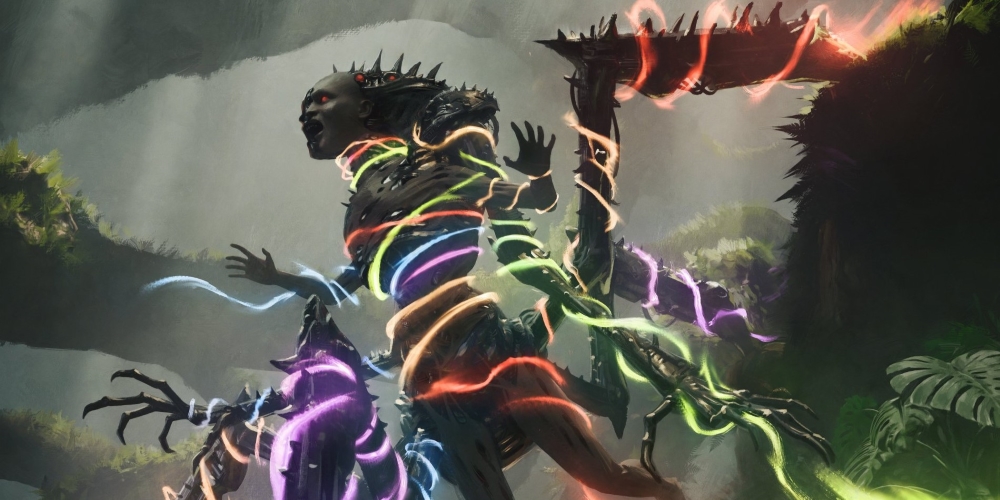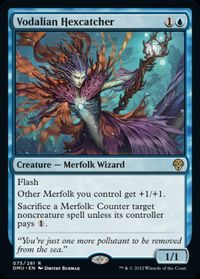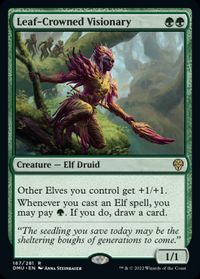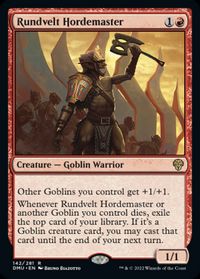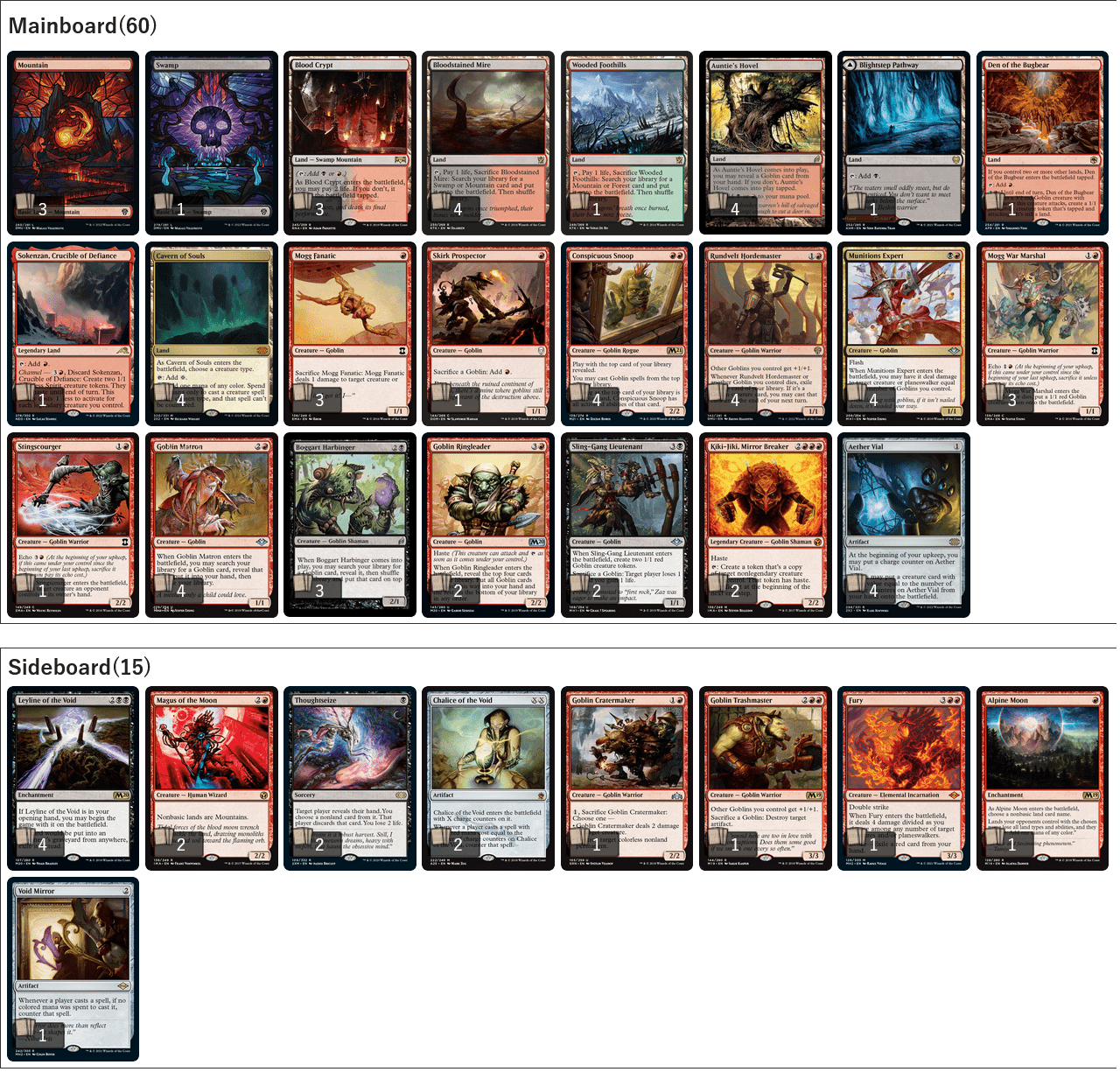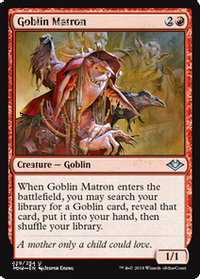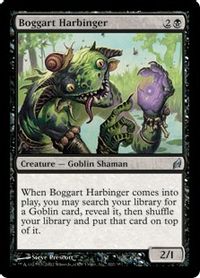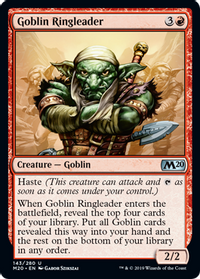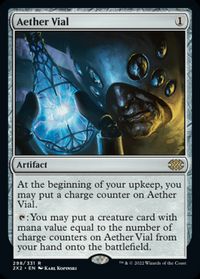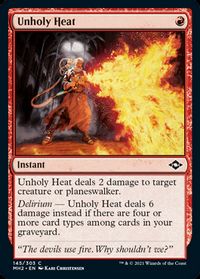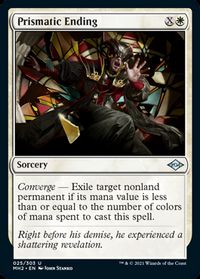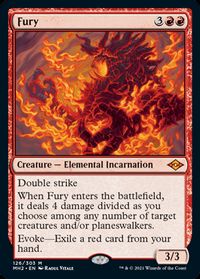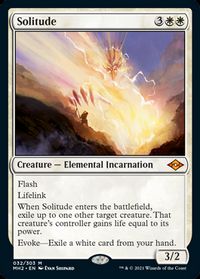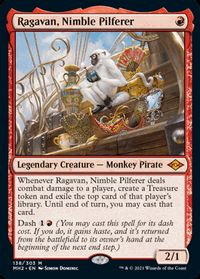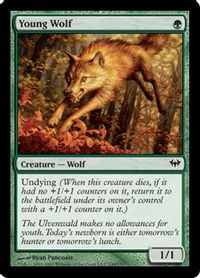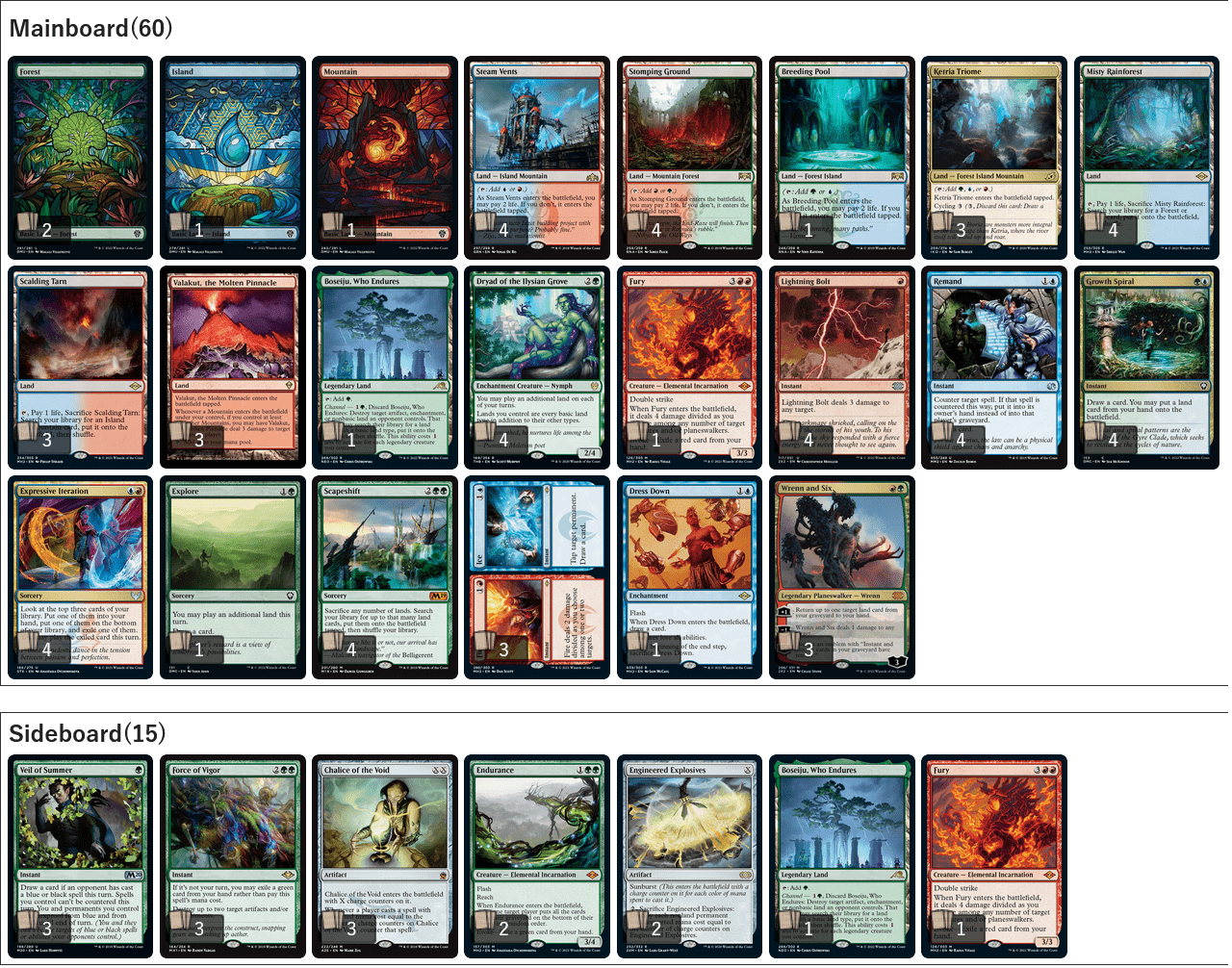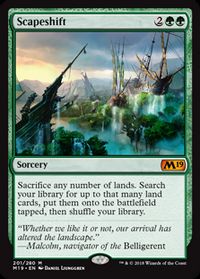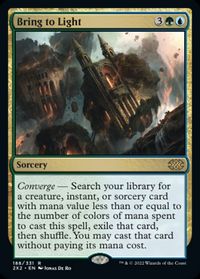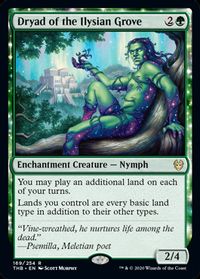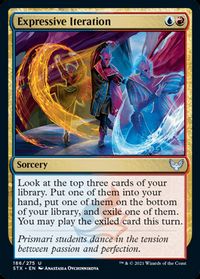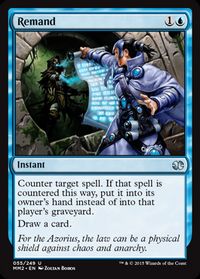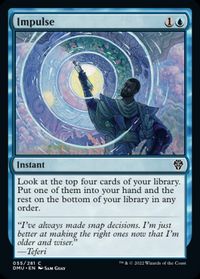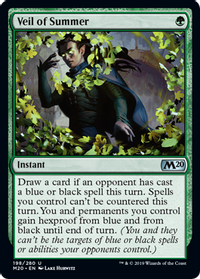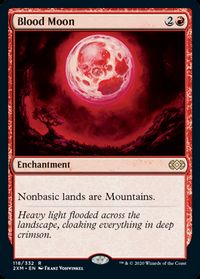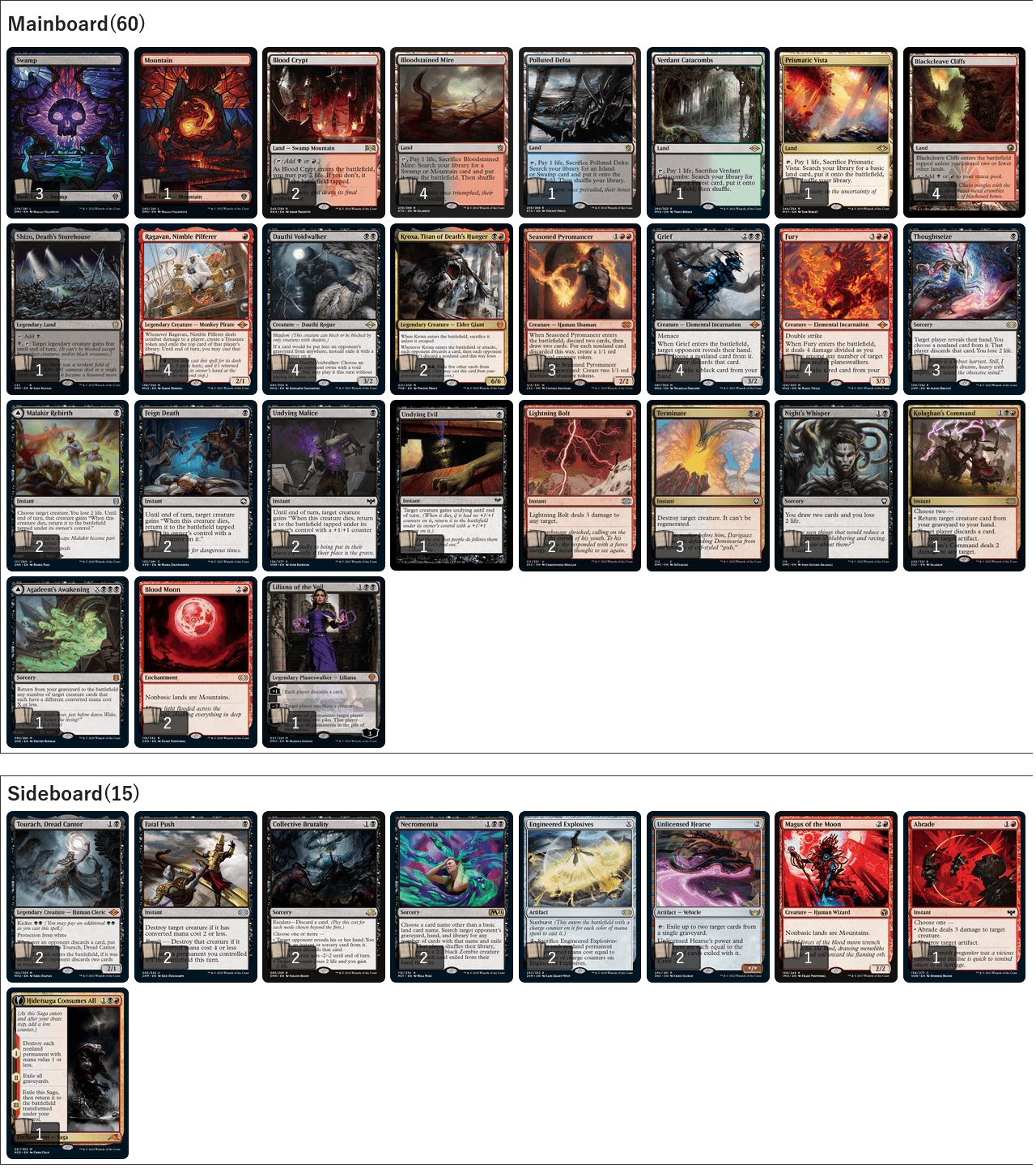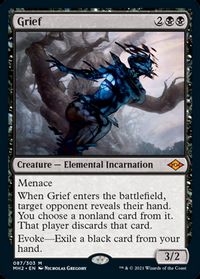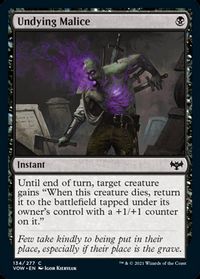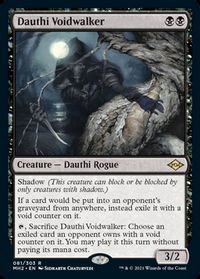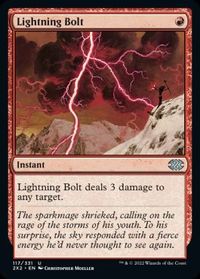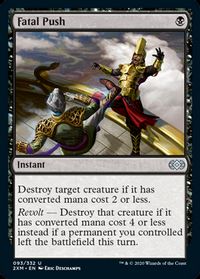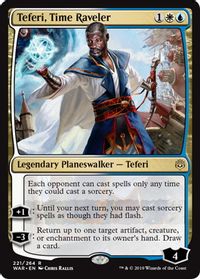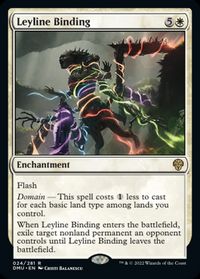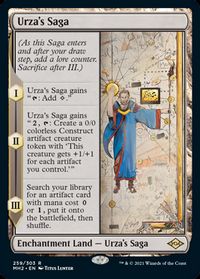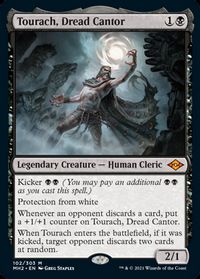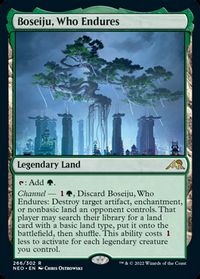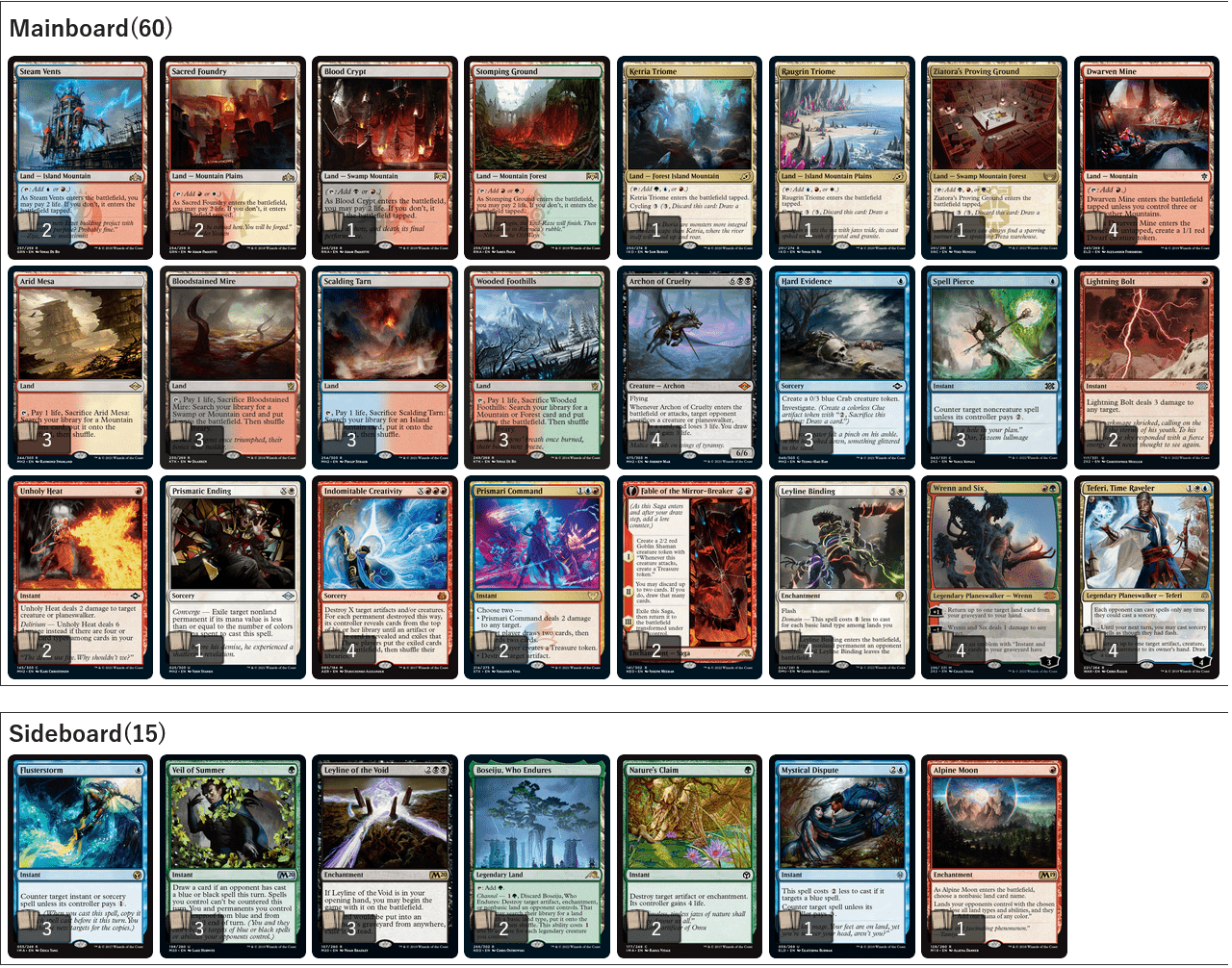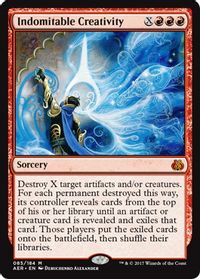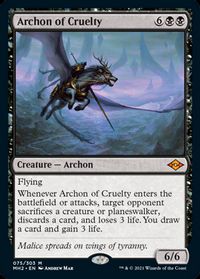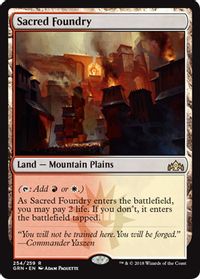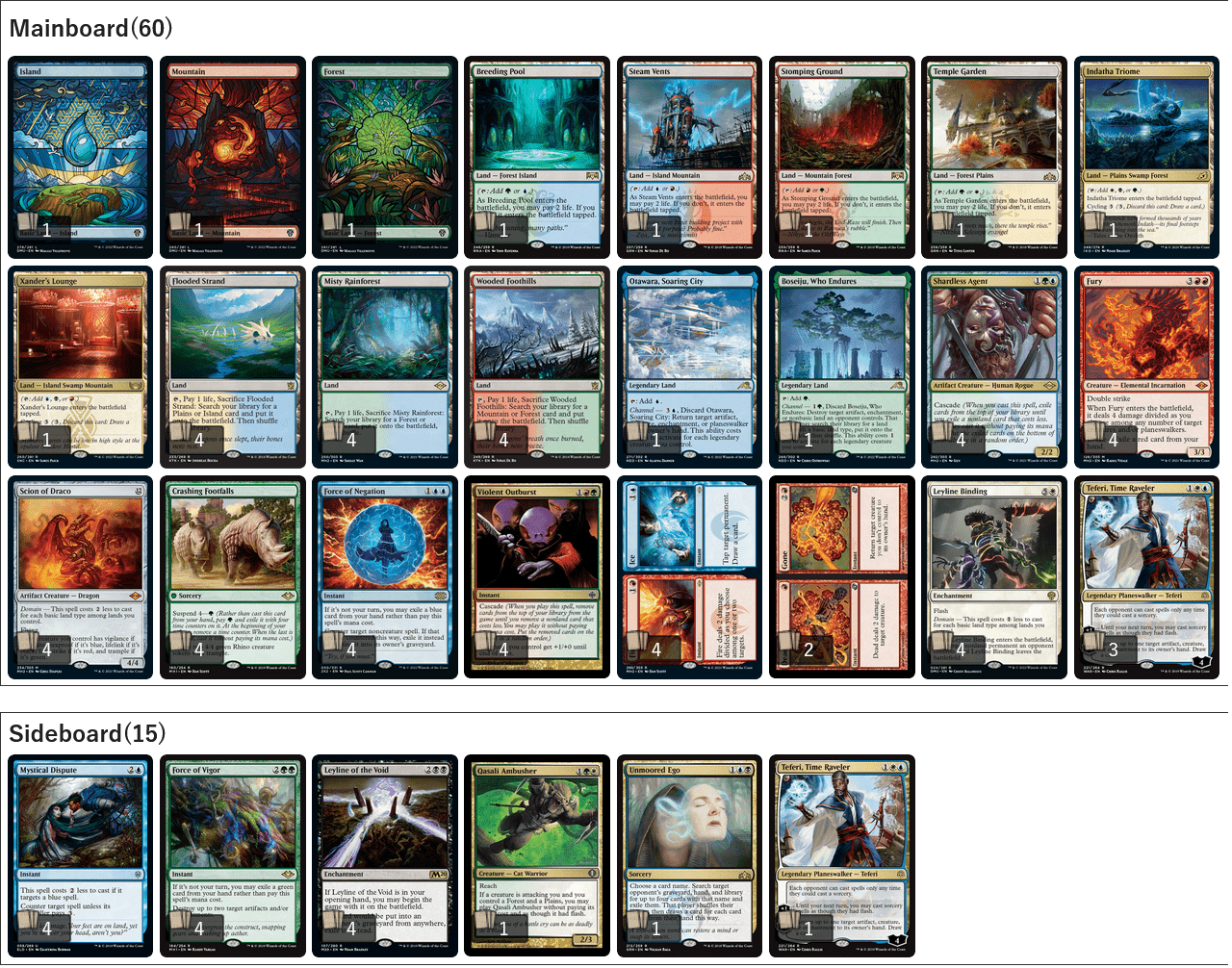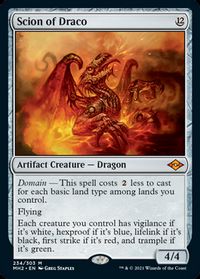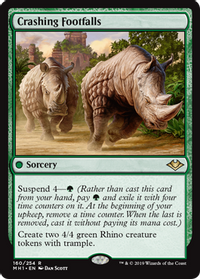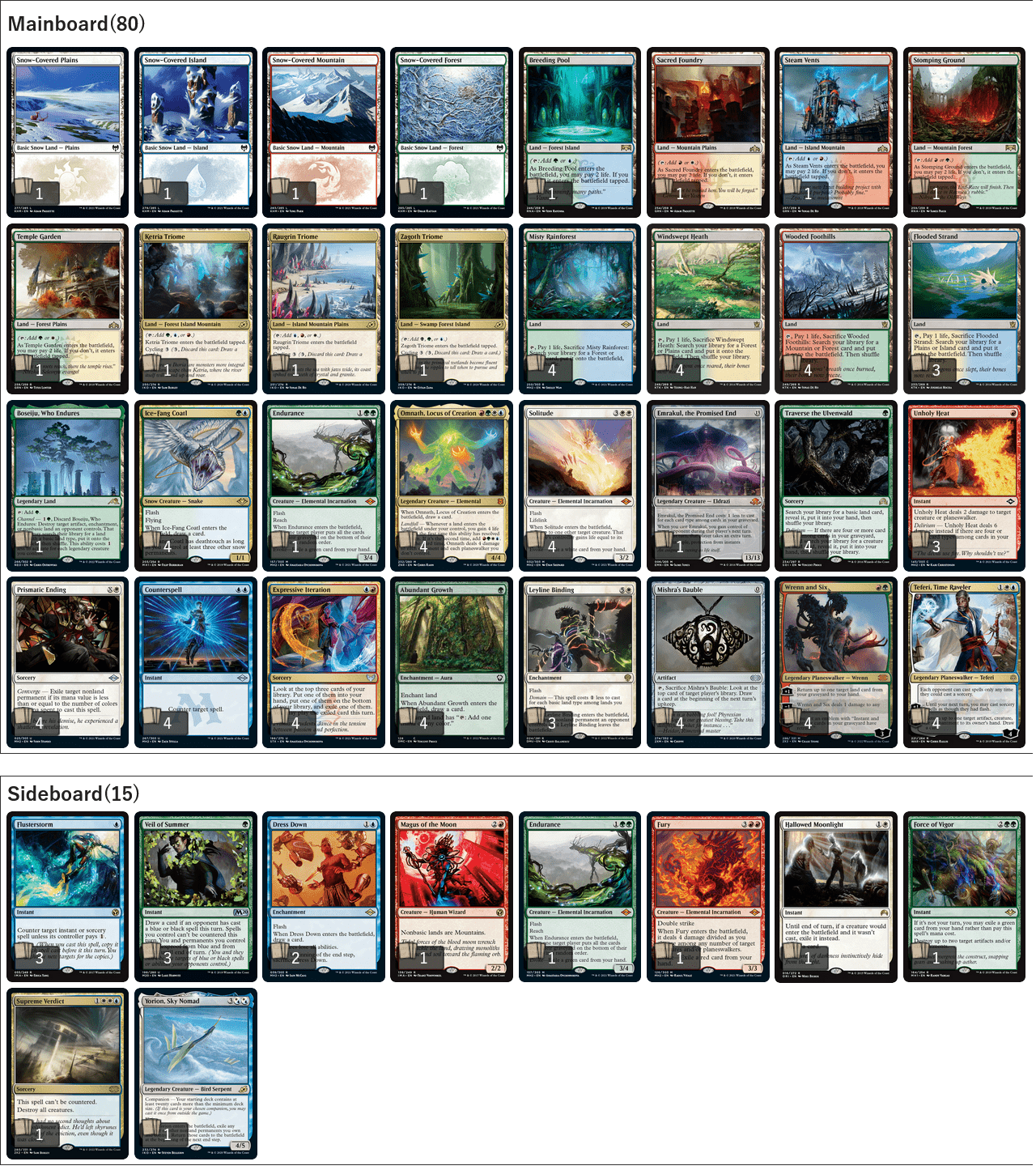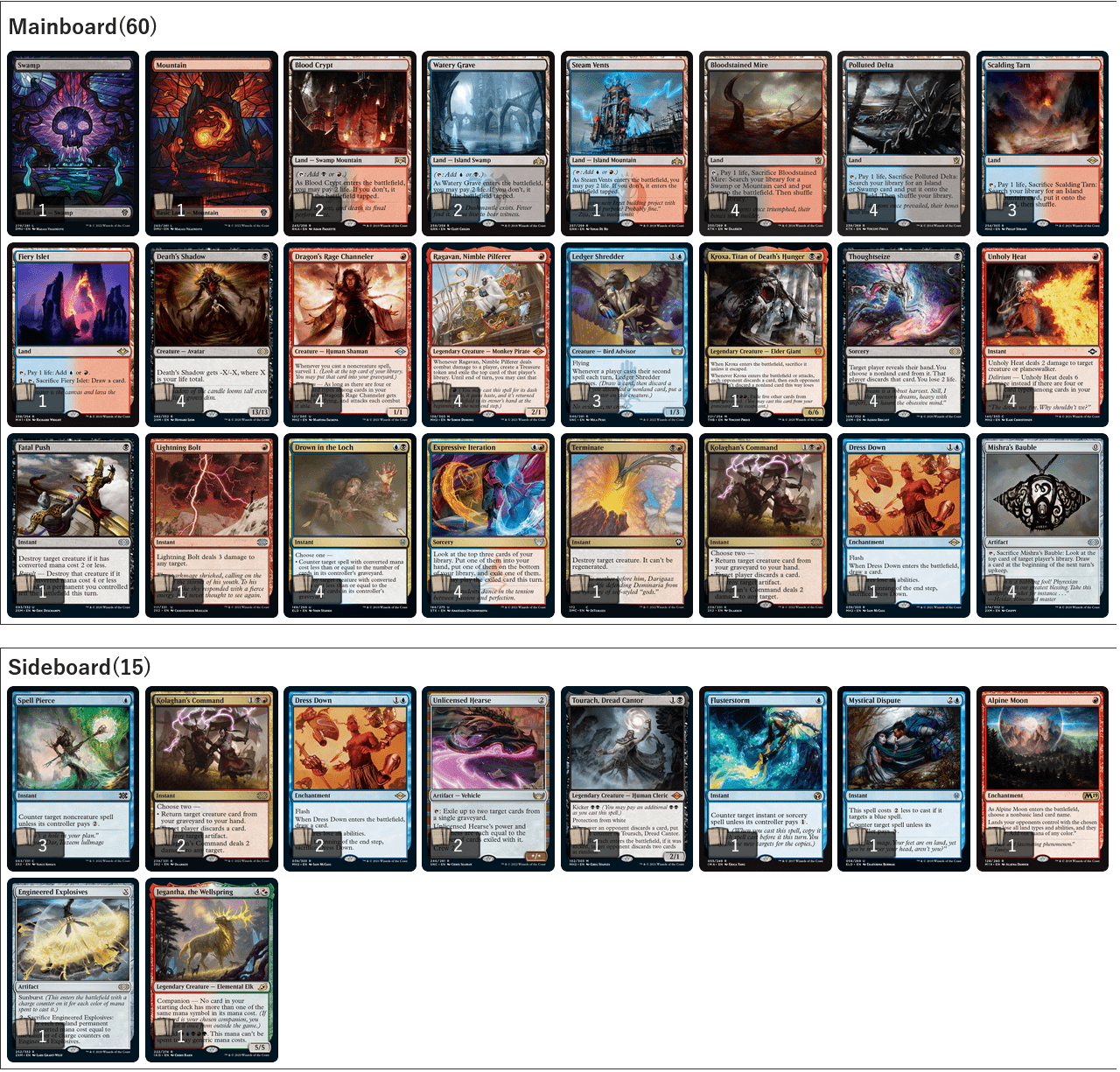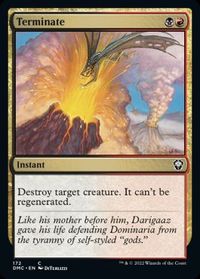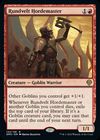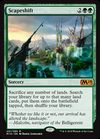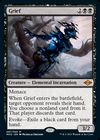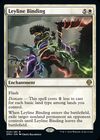Introduction
Dominaria United was released a few weeks ago. As far as Modern is concerned, it’s not a particularly powerful set, with just a handful of playable cards. After all, it has to be expected – Modern Horizons 2 created such a high barrier entry for any new card.
Few new cards don’t necessarily mean low impact – after a couple of weekends of results, we can already observe some trends.
Let’s walk through what has changed in Modern lately!
Tribal Decks
First comes a trio of lords for popular Tribes. After all, tribal decks are easy to imagine, build, and were present in magic basically forever. 《Rundvelt Hordemaster》 even won the first Modern Challenge with new cards!
Goblins
《Rundvelt Hordemaster》 fits nicely into the preexisting 《Conspicuous Snoop》 Goblin combo decks, providing an extra avenue to victory with scrappy beats, some resilience against removal, and most importantly lowering the curve of the deck.
While PlayToNguyen continues to get respectable results with Goblins, when I personally took the archetype for a spin it was quickly apparent to me that while the new addition improves the deck, it doesn’t fix some of the underlying problems.
Without a wealth of exciting options at one mana, the curve of Goblins is actually relatively high. At the same time, it’s not a deck that takes flooding out too well – tribal synergies need a critical mass of creatures, and if you draw only a few payoff creatures which will be dealt with, you risk getting stuck with just a bunch of lands and 《Mogg War Marshal》 – and that doesn’t beat anyone.
On the other hand, there is a lot of card advantage in the deck, but it can only really draw you more Goblins – not very helpful when you are missing land drops.
Therefore, Goblins is stuck in this awkward place where it runs 23 lands and 4 《Aether Vial》. When everything lines up, you draw exactly the amount of lands you need, and your turn one 《Aether Vial》 sticks, Goblins can be a very impressive deck, pressuring your opponent’s life total while threatening the combo kill.
On the flip side, it stutters and falls behind very easily. At least the 《Conspicuous Snoop》 combo will let you steal a game from behind sometimes – but in general, Goblins plays pretty poorly out of position.
Merfolk and Elves
Merfolk and Elves didn’t really perform despite getting their powerful lords. It’s unsurprising – Modern Horizons 2 introduced two great one-mana spells in 《Unholy Heat》 and 《Prismatic Ending》, making trading for cheap creatures easier than ever, not to mention 《Fury》 and 《Solitude》, the combo of which with 《Ephemerate》 was strong enough that people just don’t play strategies that want to get multiple creatures out at the same time anymore.
At the same time, 《Ragavan, Nimble Pilferer》‘s existence necessitates every fair deck to play a sufficient amount of ways to deal with it turn one on the draw. And that’s not even counting 《Wrenn and Six》, who can ping down two creatures and live! It’s just too easy to remove creatures in Modern for a strategy based around your two-drop Lord sticking in play alongside a few other members of the tribe to be exciting.
So, 《Vodalian Hexcatcher》 is an insane card to push your advantage when you are ahead on board, but how do you get on the board in the first place in Modern as we know it now?
Even if Merfolk can back up their pressure with lots of free permission spells, and best Elves draws can bring a similar to Goblins combo-like finish if uninterrupted, for tribal decks to actually ascend from their low-tier status they would need powerful one-mana cards that match up well against at least some of the problems those decks are facing.
Think of something similar to the role 《Young Wolf》 plays in Yawgmoth, a synergistic combo piece that embarrasses 《Ragavan, Nimble Pilferer》 and 《Unholy Heat》. I’m not even sure what a card like that would look like – perhaps just one mana 1/1 that comes with a token of the same tribe?
For now, tribal decks will probably remain interesting, but with the exception of tier two Goblins, not very competitive and without many prospects for playability.
Temur Scapeshift
Over the past few weeks, a relatively simple build of Temur Scapeshift has gained some popularity. 《Bring to Light》 《Scapeshift》 was an extremely minor part of the metagame for a long time, but the recent development is returning to the roots and just playing straight 《Scapeshift》 with the full intent of drawing the namesake card.
Especially as Temur Scapeshift seems to largely attempt to be yet another exploit of 4C Yorion decks, it makes sense to just try to draw your 《Scapeshift》, instead of getting your 《Bring to Light》 locked by a 《Teferi, Time Raveler》.
《Dryad of the Ilysian Grove》 makes sure that there are more threats besides just the 《Scapeshift》 itself, but the real key difference from when we last saw Temur Scapeshift played are 《Wrenn and Six》 and 《Expressive Iteration》, assuring that you never miss a land drop.
《Remand》 is also a card we haven’t seen in a while, but it’s likely the best interaction for the deck, given that, again, your entire being hinges on making every land drop possible and activating 《Scapeshift》 and 《Dryad of the Ilysian Grove》.
《Remand》 also conveniently works as a “real” counterspell against Cascade decks – so it’s a good way to fit some relevant interaction without straying away from the combo nature of the deck.
The deck first (re)appeared a few weekends before Dominaria United. It’s fully functional without any of the new cards – and the single 《Impulse》 that some lists play probably won’t stay in there for long.
I expect Temur Scapeshift to stay a small, but relatively consistent part of the broader metagame, as mostly an upgrade over the RG Titanshift decks that appeared sparingly ever since Will Krueguer made his bold and successful metagame call at the last MOCS.
Most decks trying to exploit 4C Yorion fail to produce a cohesive plan against Izzet Murktide, but need to resolve just a single namesake spell sounds doable with 《Veil of Summer》 available in your colors. 《Blood Moon》 seems very worrying and hard to tackle, though.
Rakdos Elementals
Rakdos Elementals is yet another archetype that solidified its position in Challenge results lately. Assembling 《Grief》 with an Undying trick on turn one is not as crushing as the 《Grief》/《Ephemerate》 combo – 《Undying Malice》 puts you ahead on the battlefield with a 4/3 《Grief》 in play, but strictly in terms of card advantage, it’s card-neutral.
《Fury》 will not often be a great turn-one play but can be a powerful comeback mechanism. Still, being able to go for those very tempo-advantageous plays is very welcome in a midrange deck.
I don’t have a clear grasp on the deck’s strengths and weaknesses, but the flexibility of being a functioning midrange deck with access to Evoke Elementals power plays, 《Blood Moon》, and discard seem to blend nicely.
《Dauthi Voidwalker》 is also a nightmare for Living End. If you untap with 《Dauthi Voidwalker》 and just never attack with it, you will always have an opportunity to sacrifice it in response to either removal or Living End itself, meaning 《Dauthi Voidwalker》 will end up in your graveyard, return with 《Living End》‘s effect, and exile said 《Living End》 with a void counter when it finishes resolving.
Then, the Rakdos player can flip the boards and graveyards again, while keeping 《Dauthi Voidwalker》 in play. That interaction is not the most obvious to those who haven’t seen it before but remember that you don’t have to attack with your 《Dauthi Voidwalker》 in that matchup. It’s really hard for them to escape that bind.
About Izzet Murktide and 《Leyline Binding》
The most important addition to Modern from DMU is 《Leyline Binding》 – but first, we need to talk about Izzet Murktide for a bit.
As, for extended periods of time, the most popular – and arguably the best – deck in the format, Izzet Murktide was setting lots of rules of engagement.
《Ragavan, Nimble Pilferer》 hitting you once or twice – especially when you try to catch up on the draw – can easily put you into an inescapable tempo black hole, even if you manage to deal with it later.
Blocking with a creature is not an option, as a removal spell puts you too far behind. Two mana answers like 《Wrenn and Six》 will often meet a 《Counterspell》 or a 《Spell Pierce》.
In order to minimize the number of automatic losses to 《Ragavan, Nimble Pilferer》 on the draw, players are forced to play bloated amounts of answers to the pirate monkey – for most fair decks that means running more one-mana removal.
The Dash ability puts a huge premium on that removal being instant speed too, not to get stranded with small removal with no available targets later in the game, which often happens with 《Prismatic Ending》 against smart Murktide players.
On the other side of the scale, we had the second key threat from the Izzet deck, 《Murktide Regent》 itself. Most of the value from 《Murktide Regent》 comes from how despite the word not appearing in the textbox, it has virtual hexproof from lots of removals.
There is no removal spell that will cover both the Monkey and the Dragon in all the ways you need, making that an excellent core of the threat suite of Izzet Murktide – as we are all familiar with, I bet.
Since point removal hits diminishing returns quickly, and 《Ragavan, Nimble Pilferer》 removal needs to be prioritized as it needs to be found earlier in the game, dealing with 《Murktide Regent》 without losing the exchange on mana or going down on cards was often impossible to even in white decks.
《Solitude》 often presented you with the damned if you do, damned if you don’t choice of trying to deal with 《Murktide Regent》 inefficiently by hard casting it (and risking getting blown out by a timely 《Counterspell》) or pitching and spending two spells to kill it, risking falling too far behind in card advantage and lose to a follow-up 《Expressive Iteration》.
《Teferi, Time Raveler》 matches up well against 《Murktide Regent》, but once again it’s both sorcery speed, and more expensive than a 《Counterspell》, so it’s hard to line up profitably.
《Leyline Binding》
Enter 《Leyline Binding》!While it’s not a full solution to the 《Ragavan, Nimble Pilferer》/《Murktide Regent》 removal conundrum, it’s a big step toward one. It won’t deal with 《Ragavan, Nimble Pilferer》 on turn one on the draw, but it will quickly become a one-mana Flash play by the second or third turn of the game, letting you double-spell and actually catch up, making one or two 《Ragavan, Nimble Pilferer》 hits, not game over.
《Murktide Regent》 is much harder to protect from a one mana flash removal spell, and many games boil down to dropping and protecting a timely Dragon for a turn.
Of course, Murktide isn’t the only deck in the format! Outside of that matchup, 《Leyline Binding》 is just a very solid and efficient removal spell. Hitting any nonland permanent means that the only things out of reach are 《Urza’s Saga》 and 《Tourach, Dread Cantor》.
《Oblivion Ring》 style template is also a huge downside against decks able to access 《Boseiju, Who Endures》 repeatedly; Amulet Titan or 《Wrenn and Six》 can punish 《Leyline Binding》 pretty hard. Besides those cases, it’s an excellent removal spell if your deck can support the domain requirement.
《Indomitable Creativity》 Combo
《Indomitable Creativity》 is extremely happy to pick up the card – 《Archon of Cruelty》 was frequently the only way to deal with 《Murktide Regent》 or a 《Ledger Shredder》 with a counter, and achieving Domain is basically an afterthought in the archetype.
More insurance against 《Engineered Explosives》 and 《Blood Moon》 also doesn’t hurt. Additionally, broad interaction is very welcome in this combo-control deck; even if not all builds that perform well incorporate 《Leyline Binding》! At the very least 《Leyline Binding》 is another strong pull towards playing white, on top of 《Teferi, Time Raveler》.
One of the issues I had with the 《Teferi, Time Raveler》 splash in 《Indomitable Creativity》 was the extra pressure on my mana. 《Sacred Foundry》 was generally pretty bad, and the deck aimed to cast 《Wrenn and Six》 and one mana blue spells already. Letting 《Sacred Foundry》 be generally more useful is a notable upgrade.
Cascade
Cascade decks are incredibly happy to get a removal spell they can use before turning three. 《Leyline Binding》 is a functional removal spell in most matchups, but also covers permanent hate like 《Chalice of the Void》 or 《Teferi, Time Raveler》 post board, improving the resiliency of the strategy.
《Scion of Draco》 gets reintroduced to the deck as the Domain requirement is redundant and it’s yet another card you can play before turn three. I’m not convinced 《Scion of Draco》 has staying power – its mana base requirements give you much less leeway than 《Leyline Binding》, it’s not really all that useful outside of casting it on turn two, and as a colorless card it can’t be pitched to any of your free spells.
But what 《Leyline Binding》 adds to the deck is quite impressive, letting Rhinos interact earlier, more often, and better. There’s just one thing I can’t wrap my mind around – the stock decklist runs only 23 lands with two Channel lands! With the additional stress, the need to fetch all five colors puts on the mana base, I would personally go with 24 or maybe even 25 lands.
One other note is that between the emergence of Rakdos and the release of 《Leyline Binding》, Rhinos might become my more-liked Cascade deck in the metagame. With Rakdos and 《Dauthi Voidwalker》 rising in popularity, I might just choose to go with the powered-up Rhinos deck now.
4C Yorion
Regular 4C Yorion lists are also a solid home for 《Leyline Binding》. 《Leyline Binding》 is not that impressive if you can’t reduce its cost down to 1, so MentalMisstep decided to add a third, black, triome to the deck.
《Zagoth Triome》 as the splash land of choice is pretty smart – fetching 《Sacred Foundry》 turn 1 into 《Zagoth Triome》 turn 2 lets you play either a 《Prismatic Ending》 or 《Unholy Heat》 on turn one, while still casting a one mana 《Leyline Binding》 on turn 2.
《Leyline Binding》 is the best card in the set, and I believe it will influence which threats we play in Modern for the foreseeable future. The deckbuilding constraints are a little bit weird and will take time to iron out fully,
Grixis Shadow
Congrats to the winner of the Grand Open Qualifier in Paris, Daniele Frontuto! The past few weeks of results seem to yield a slightly lower representation of Izzet Murktide compared to what we are used to – makes sense, as we discussed the implications of 《Leyline Binding》 on the format.
If that trend persists, I think the deck gaining a lot from it would be Grixis Shadow. I typically view Grixis as generally ever so slightly better against the rest of the field but suffering a lot against the Izzet tempo deck mirror – handling 《Murktide Regent》 was never easy for Grixis.
《Terminate》 is not a card you actually want to play, so I respect the players who showed up with zero or one copy in the maindeck with the intention to dodge the matchup. Seems like a wise choice!
On the other hand with 《Leyline Binding》 increasing the amount of white removal in the format I’d definitely look to play a second 《Tourach, Dread Cantor》.
Of course, there is also a subset of deks that exploit specific weaknesses of Grixis that you’d rather not play against. Burn exploits the more painful manabase, while occasional Tron decks laugh at 《Drown in the Loch》, so while there might be weekends where Grixis might be a better choice – but you need to pick your spots carefully.
Even if Murktide had a couple of worse weekends lately, I wouldn’t count the deck out! It’s still such a solid and flexible deck all-around, but 《Leyline Binding》 entering the removal suites might just mean that there are some actually bad matchups out there. As of writing, the last Sunday Modern Challenge
Conclusion
Overall, while we see constant little shakeups in the formats, with decks adapting, old decks reemerging in new ways, and the landscape constantly changing a little bit, this is about the pace of change in Modern I’d expect from Standard-legal sets, introducing one or two powerful cards with a few fringe lower power level additions here and there.
Until next time!


